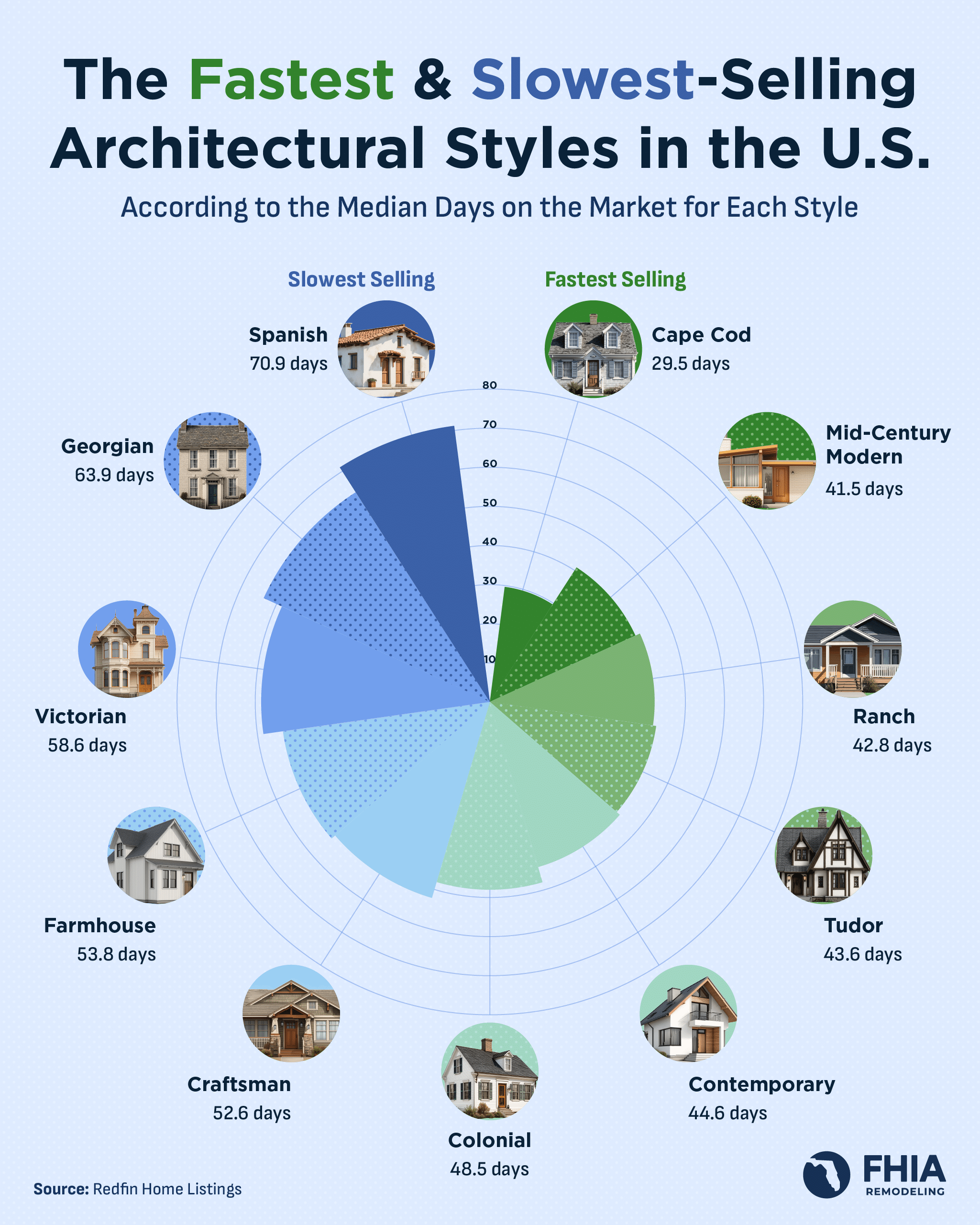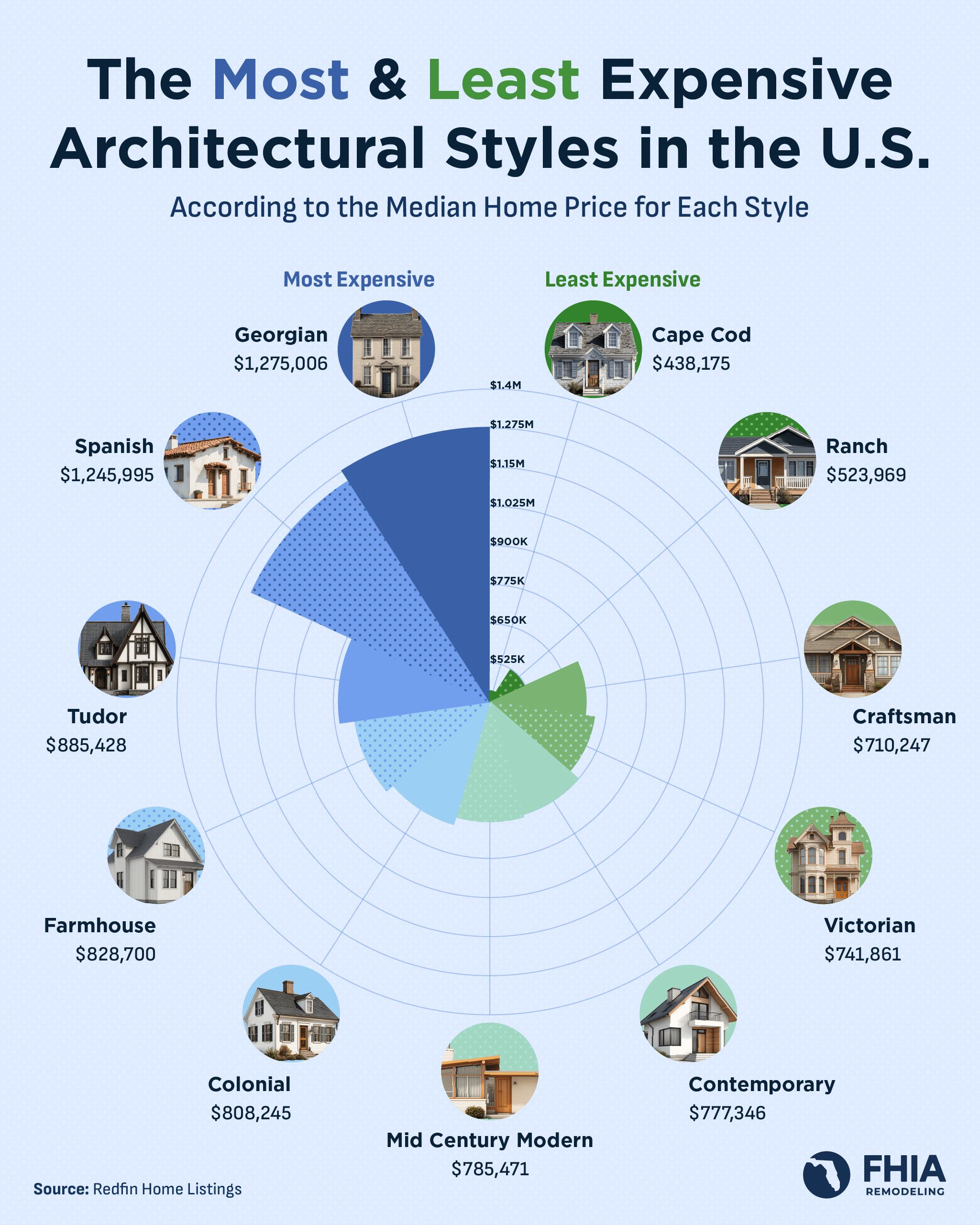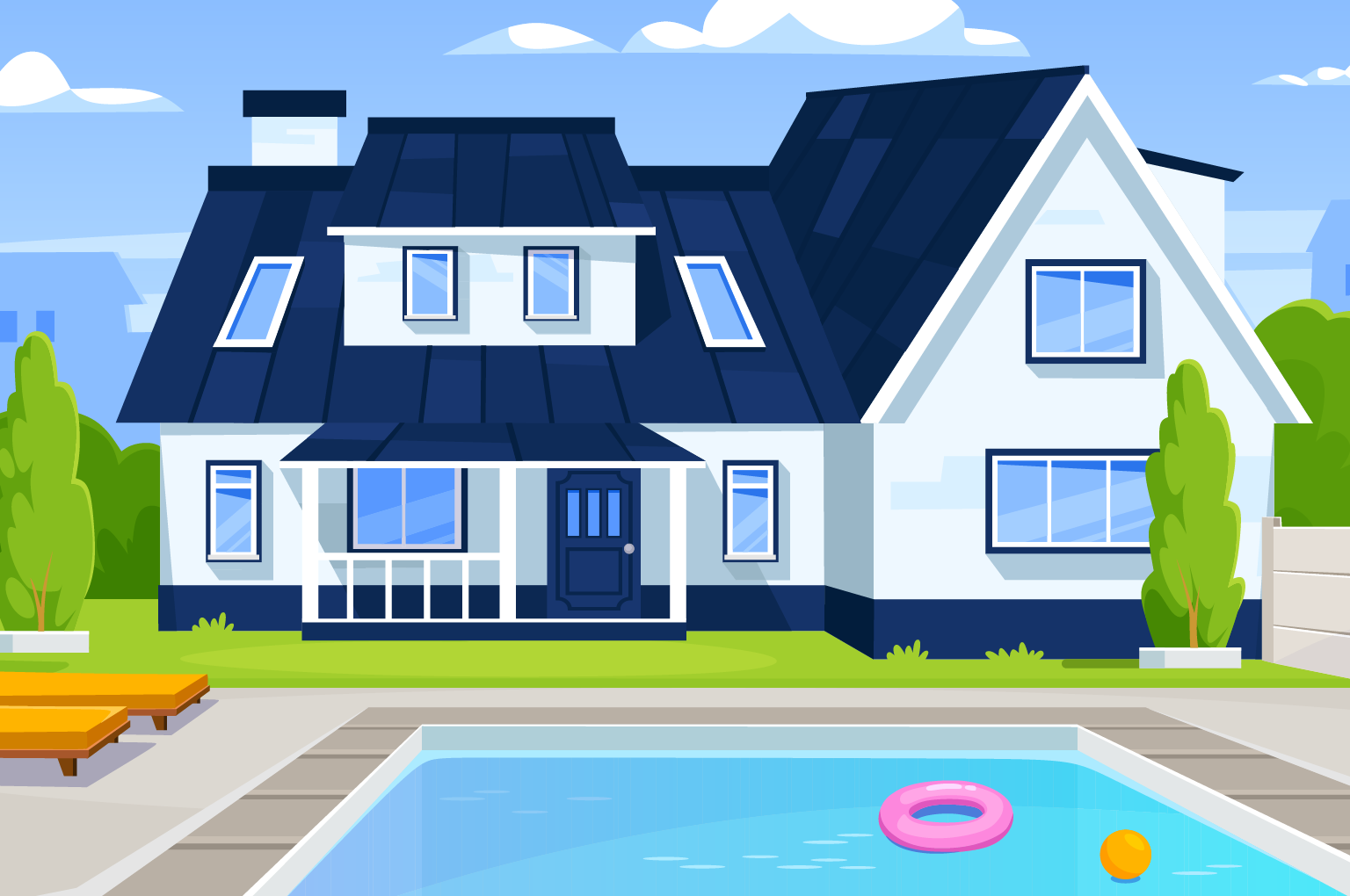
Table of Contents
- House Features That Cost the Most
- Costs in Florida Cities
- The Cost of House Features in U.S. Cities
- Closing Thoughts
- Methodology
Some home features add more than just style. They significantly affect what a house is worth. A porch becomes a second living room, an office offers space to focus. But depending on where you live, those upgrades will cost you. And in some places, they’ll cost you a lot.
We analyzed home listings from Redfin in 50 of the largest U.S. cities to see how much more buyers are paying for popular features like porches, garages, fenced backyards, and home offices. The results show where each upgrade adds the most value and where you might be better off improving your current space rather than buying new.
House Features That Cost the Most
To get a better sense of how popular house features impact price, we looked at active listings in 50 major U.S. cities and compared the average list price for homes with and without each amenity. The results show a wide range of price differences: some steep, others surprisingly modest.
Here’s how the national averages shake out:
- Office – 32.0% increase | +$208,894
- Garage – 17.3% increase | +$113,363
- Porch – 2.2% increase | +$14,060
- Fenced Backyard – 22.5% decrease | –$146,769
Whether it’s about comfort, functionality, or outdoor living, each home feature comes with a different price point. And in some cities, the premium is even higher.
Let’s start with a home feature that blends lifestyle and productivity in an increasingly online world: the home office.
House Feature: Office
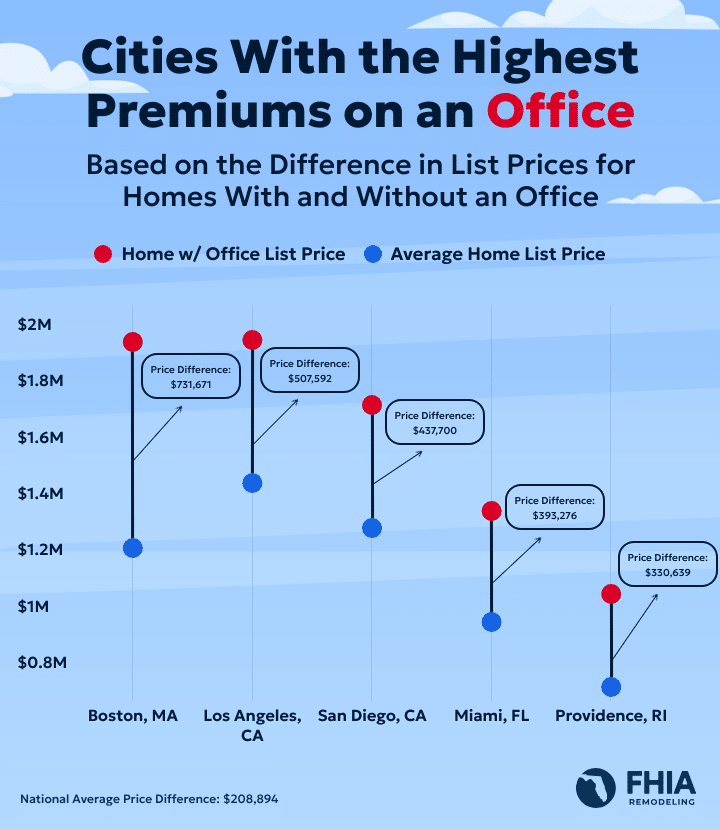
Working from home might be more common than ever, but a dedicated office is a house feature that not everyone can afford. That added square footage can come at a premium. Across the 50 cities we analyzed, homes with a designated office space were priced $208,894 (32%) higher than those without.
These cities had the highest price bumps for homes with an office:
Boston, MA
-
- Home with an office: $1,970,890
- Average home: $1,239,219
- Cost difference: $731,671
- Price increase: 59%
Los Angeles, CA
-
- Home with an office: $1,977,762
- Average home: $1,470,170
- Cost difference: $507,592
- Price increase: 34.5%
San Diego, CA
-
- Home with an office: $1,748,339
- Average home: $1,310,639
- Cost difference: $437,700
- Price increase: 33.4%
Miami, FL
-
- Home with an office: $1,371,395
- Average home: $978,119
- Cost difference: $393,276
- Price increase: 40.2%
Providence, RI
-
- Home with an office: $1,077,786
- Average home: $747,147
- Cost difference: $330,639
- Price increase: 44.3%
In markets like Boston, Los Angeles, and Miami, where space is already tight, an extra room, especially one that can double as a workspace, can significantly raise a home’s value.
It makes sense: in many cases, you’re paying for what amounts to an extra bedroom. Whether it’s used for work, school, or a creative outlet, a home office adds flexibility and homebuyers better be willing to pay for it.
Next, we’ll look at another popular home feature, porches, and the surprising cities where a home with one comes at a premium.
House Feature: Porch
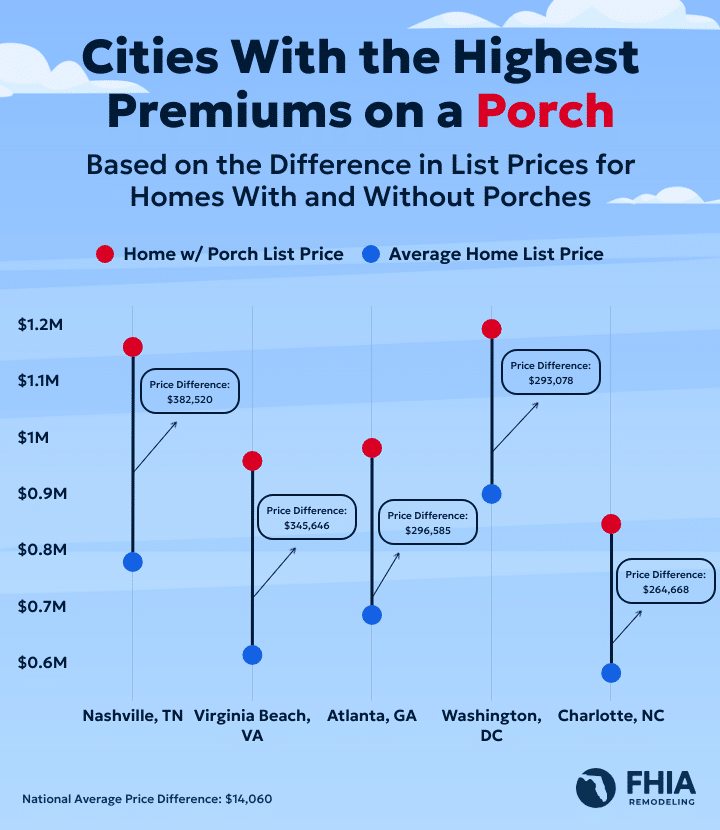
We’ll begin our study with a home feature that populates many dream home blueprints: the porch.
There’s nothing like an evening spent on the porch: rocking chairs, a tasty drink, and just enough breeze to stir the wind chimes without making you uncomfortable. It’s a quaint daydream but depending on where you live, that kind of comfort may be more of a nightmare.
On average, homes that feature porches were priced $14,060 higher than those without them. A modest 2.2% increase, but one that climbs much higher in certain markets. These are the cities where a porch adds the most value:
Nashville, TN
-
- Home with a porch: $1,177,413
- Average home: $794,893
- Cost difference: $382,520
- Price increase: 48.1%
Virginia Beach, VA
-
- Home with a porch: $974,809
- Average home: $629,163
- Cost difference: $345,646
- Price increase: 54.9%
Atlanta, GA
-
- Home with a porch: $998,399
- Average home: $701,815
- Cost difference: $296,585
- Price increase: 42.3%
Washington, DC
-
- Home with a porch: $1,208,397
- Average home: $915,319
- Cost difference: $293,078
- Price increase: 32.0%
Charlotte, NC
-
- Home with a porch: $862,458
- Average home: $597,790
- Cost difference: $264,668
- Price increase: 44.3%
That serene scene we described earlier makes the most sense with a warm, quiet backdrop behind it, so it’s no surprise that homes in the Southeast have a strong showing here. Their warm weather and strong traditions of outdoor living make porches an especially desirable home feature.
Ideal for hosting, relaxing, or catching a summer sunset, cities like Nashville, Atlanta, and Charlotte have long embraced the porch as an extension of the living space. Just be prepared to pay an excess of $200,000 more than other homes in the area if a big porch is part of your must-have list when house hunting.
With figures like these, porches are clearly both a lifestyle improvement and a long-term investment in your property but there are other, more affordable, upgrades available that can boost your home’s appeal. Adding energy-efficient windows can help maintain a cooler indoor temperature, lower utility bills, and improve comfort all season long.
Next, we’ll explore another popular home feature, fenced backyards, and the cities where outdoor space and privacy will cost you the most.
House Feature: Fenced Yard

Whether it’s to keep the kids safe, give pets room to roam, or enjoy a little more privacy outdoors, a fenced yard is a must-have house feature for many homeowners. But surprisingly, having one doesn’t usually come with a higher price tag.
In fact, across the cities we analyzed, homes with fenced yards were actually $146,769 cheaper than the average. That’s about 22.5% less than the average home. Still, there are a few cities where fenced yards do command a higher price:
Boston, MA
-
- Home with a fenced yard: $1,462,145
- Average home: $1,239,219
- Cost difference: $222,926
- Price increase: 18%
Cleveland, OH
-
- Home with a fenced yard: $309,850
- Average home: $179,626
- Cost difference: $130,224
- Price increase: 72.5%
Denver, CO
-
- Home with a fenced yard: $832,590
- Average home: $735,736
- Cost difference: $96,854
- Price increase: 13.2%
Raleigh, NC
-
- Home with a fenced yard: $688,390
- Average home: $650,528
- Cost difference: $37,862
- Price increase: 5.8%
Milwaukee, WI
-
- Home with a fenced yard: $320,665
- Average home: $283,117
- Cost difference: $37,547
- Price increase: 13.3%
In most cities, a fenced yard doesn’t seem to drive up list prices, which could make it one of the more accessible house feature upgrades for homeowners. But in denser cities like Boston or Cleveland, where private outdoor space may be harder to come by, a fenced yard can still set a property apart.
While it may not bring the highest return in market value, a fenced yard can add a lot of day-to-day value. Especially in places where outdoor time is what we want the most!
For homeowners in storm-prone regions, a fenced yard is only one piece of the protection puzzle. Durable upgrades like impact windows can help protect your home from wind and debris during storms, while still letting in plenty of light year-round.
Next, we’ll take a look at the cost of one of the most practical, versatile home features of all: the garage.
House Feature: Garage

A garage is one of the most functional house features people seek out. Great for parking, storage, or even converting into extra living space. But in many markets, they come at a cost.
On average, homes with garages were listed for $113,363 more than those without, an increase of 17.3%. These cities saw the biggest price jumps for homes with garages:
Boston, MA
-
- Home with a garage: $1,783,622
- Average home: $1,239,219
- Cost difference: $544,403
- Price increase: 43.9%
Washington, DC
-
- Home with a garage: $1,367,481
- Average home: $915,319
- Cost difference: $452,162
- Price increase: 49.4%
Virginia Beach, VA
-
- Home with a garage: $909,043
- Average home: $629,163
- Cost difference: $279,881
- Price increase: 44.5%
Philadelphia, PA
-
- Home with a garage: $672,385
- Average home: $407,222
- Cost difference: $265,163
- Price increase: 65.1%
Baltimore, MD
-
- Home with a garage: $534,523
- Average home: $315,825
- Cost difference: $218,698
- Price increase: 69.2%
In many of these East Coast cities, houses that feature a garage are in shorter supply, especially in older neighborhoods where street parking is the norm. That scarcity helps explain why buyers in places like Baltimore and Philadelphia are paying steep premiums for homes that include one.
Whether you use it for parking, storage, or a workshop space, a garage adds year-round functionality that homebuyers covet no matter where they’re looking to buy. Pairing a garage with strong, weather-resistant impact doors adds another layer of protection, which is especially important during storm seasons.
To wrap up our analysis, we wanted to take a closer look at what these home features cost residents of Florida cities, specifically.
Costs in Florida Cities
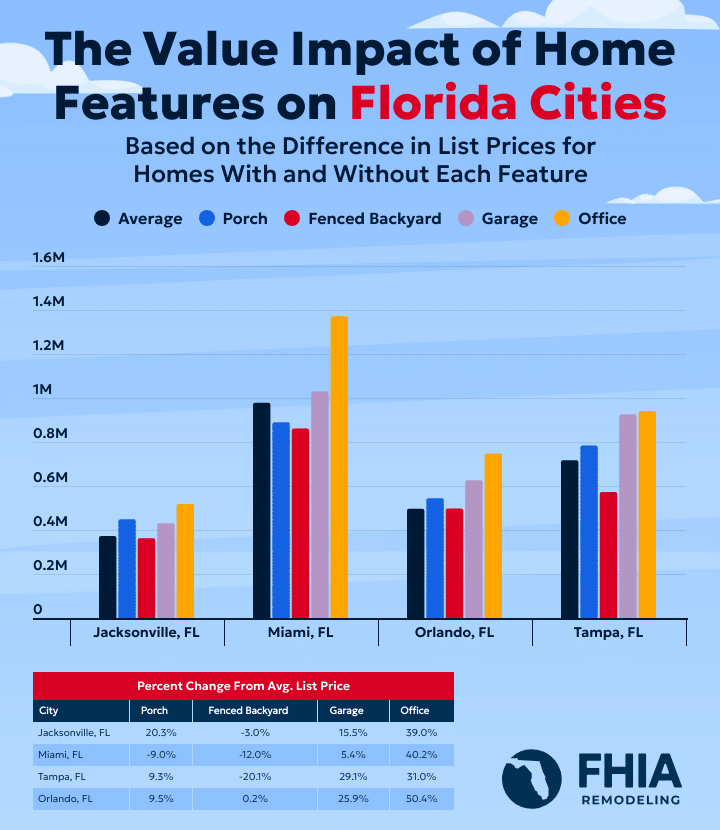
It’s clear that some features add more value than others depending on where you’re buying. With FHIA Remodeling serving homeowners across the state, we wanted to take a closer look at how popular home features impact prices in four major Florida markets.
Here’s what we found:
Home offices: All four cities showed strong price increases for homes with office space. The highest jumps were seen in Orlando (50.4%) and Miami (40.2%), likely reflecting ongoing demand from remote workers and out-of-state buyers relocating to Florida.
Fenced backyards: These didn’t add much to overall home value in Florida. Jacksonville, Tampa, and Miami even saw price decreases. Fenced yards may be common enough in these areas that they don’t stand out as premium features.
Garages and porches: Both features added value in all four cities, but the increases were more moderate. Still, they reflect Florida homeowners’ desire for functional, flexible spaces that support outdoor living and storage.
Whether you’re upgrading your Miami home with a new porch or adding a fenced yard to your Orlando space, these trends show that thoughtful home feature improvements can make a big difference. For all Florida homeowners, one smart upgrade that both provides peace of mind and adds property value is installing hurricane windows to offer added protection when the storms start rolling in.
Now that we’ve looked at each feature on its own, let’s wrap things up by taking a look at all the amenities we analyzed side by side.
The Cost of House Features in U.S. Cities
Curious how much a pool, porch, or fenced yard adds to the cost of a home in your city?
We’ve broken down the full results of our analysis for all 50 cities in our study. You can search for your city directly, sort by each home feature, or explore the full data table below to see how the numbers compare across the U.S.
Closing Thoughts
From porches and garages to home offices and fenced yards, our analysis shows just how much value buyers place on functional home features. In many cities, these upgrades can raise a home’s price by tens—or even hundreds—of thousands of dollars.
But you don’t have to move to enjoy these benefits. Whether you’re looking to boost curb appeal, add usable space, or just make your home more comfortable, smart upgrades can go a long way. From roof work to improving windows and doors, you can help keep your home comfy and cut costs.
FHIA Remodeling helps Florida homeowners make updates that matter, so your home works better for you year-round.
Methodology
To identify the most expensive house features, we analyzed the average price of all active home listings in America’s 50 largest cities and compared them to the average price of listings that included the following features:
- Porch
- Fenced Backyard
- Garage
- Office
Our analysis focused on finding the cities with the largest percent changes in average home list prices to homes that had the features we considered. Our goal was to highlight the cities with the largest differences in average home prices based on the presence of each feature. All observed home price data comes from Redfin.

